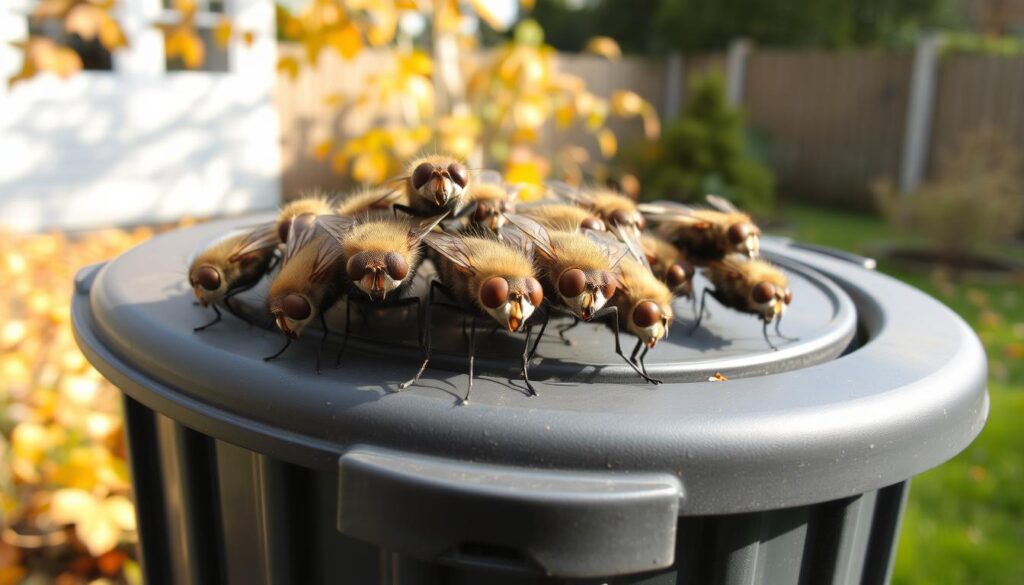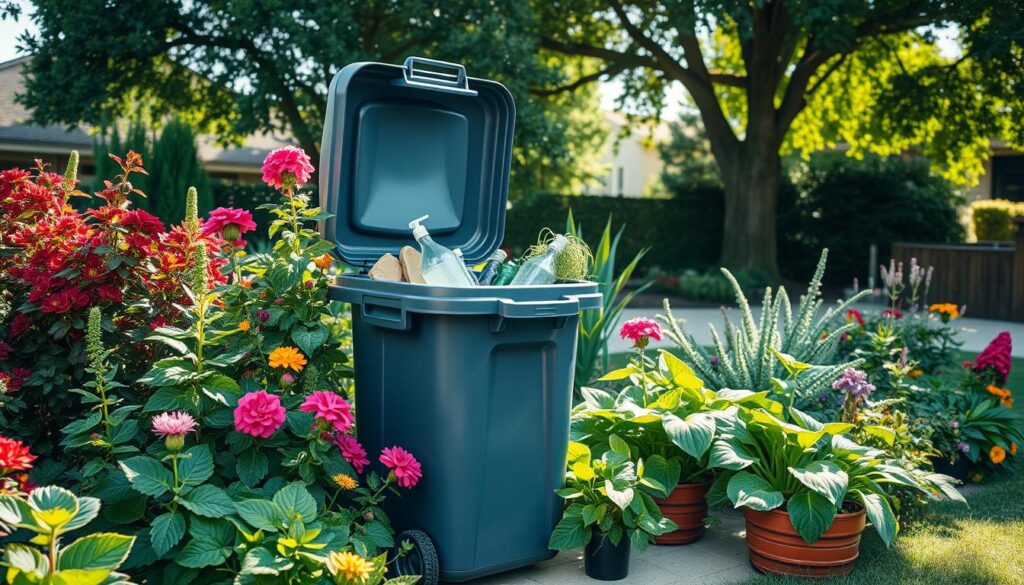Are your wheelie bins home to unwanted guests? The dreaded cluster fly can turn your bin into a breeding ground. This creates an unsanitary and unpleasant situation. But how can you tell if you have a cluster fly infestation? Here are 5 telltale signs to watch out for:
While cluster flies may seem harmless, they can quickly become a nuisance if left unchecked. Recognising the early signs of an infestation is key. This helps prevent it from getting worse and protects your home from maggot infestations, unpleasant odours, and other sanitation issues. Stay vigilant, and take swift action to address any potential wheelie bin fly problems before they worsen.
Key Takeaways
- Wheelie bin fly infestations can lead to maggot issues, unpleasant odours, and sanitation problems if left unchecked.
- Recognising the early signs of a cluster fly infestation is crucial for effective pest management.
- Taking proactive measures to address potential wheelie bin fly problems can help prevent the infestation from escalating.
- Seeking professional advice and treatment can be beneficial for severe cluster fly infestations.
- Maintaining proper bin hygiene and waste disposal practices is key to deterring flies and other pests.
Identifying Cluster Flies: The Culprits Behind Bin Infestations
Appearance and Characteristics
Cluster flies are often found in wheelie bins. They are about 8mm long and dark grey. They have golden hair patches and long wings.
They are bigger than houseflies and bluebottles. They move slowly. This makes them easy to spot.
Cluster flies appear in spring. They lay eggs outside and then find warm places to sleep in August. This is different from other flies.
| Fly Species | Characteristics | Breeding Grounds | Seasonal Presence |
|---|---|---|---|
| Cluster Flies | Dark grey, 8mm long, golden hair patches | Outdoors, then hibernate in homes | Spring, hibernate in late summer |
| Houseflies | Smaller, grey-black, common house pests | Decaying organic matter | Year-round, more prevalent in summer |
| Bluebottles | Metallic blue-green, larger than houseflies | Decaying organic matter | Spring to autumn |
| Fruit Flies | Tiny, around 1/8 inch long, attracted to ripe fruit | Overripe fruit, sugary substances | Summer, more prevalent in hot weather |
Knowing about cluster flies helps fight bin infestations. Homeowners and pest experts can tackle the problem better.
Recognising the Signs of a Cluster Fly Infestation
Spotting a cluster fly problem in your home is key to solving it. These pests like warm, safe spots. So, they hide in places like attics and under sunken lights.
They often come back to the same spots every year. This happens unless you seal their entry points.
Cluster flies are 8-10mm long and have a dark grey body. They have golden-yellow hairs on their thorax. If you see lots of flies near your windows, especially at night, it might be a sign.
Another sign is fly larvae, or maggots. They are 3-9mm long and like to be together. Seeing maggots and lots of flies means you have a problem.
Being careful and watching for early signs is important. Look for flies, maggots, and the same spots being used again. Getting help from a pest control service, like DALPEST Pest Solutions, can also help a lot.

“Cluster flies are a common seasonal problem, being more prevalent during warmer summer and autumn seasons. Identifying and addressing the issue early on is key to preventing a full-blown infestation.”
Wheelie Bin Fly Infestation: The Breeding Grounds
Wheelie bins can attract cluster flies. They like rotten organic matter and food waste. Keeping bins clean is key to stop flies.
Flies can lay eggs quickly. These eggs hatch into maggots in just 24 hours. It’s important to manage household waste well.
Using wheelie bins helps keep flies out. In hot weather, change bins weekly. This helps avoid infestations.
Clean recycling materials to stop flies. Use fly-spray or boiling water with bleach for maggots. Clean bins with disinfectant or bleach.
| What Attracts Flies to Wheelie Bins | How to Prevent Fly Infestations |
|---|---|
|
|
Manage waste and keep bins clean to avoid flies. Good waste management keeps your bin and community healthy.
The Dangers of Fly Infestations in Commercial Settings
Cluster flies are a big problem in places like restaurants. They can make food dirty and cause big fines. They also make a bad smell and are harmful to health.
Health and Safety Risks
Flies can carry over 100 sicknesses. This includes diseases like typhoid and cholera. In kitchens, they can make food unsafe for everyone.
- Each female housefly can lay up to 500 eggs in several batches, with each batch ranging from about 75 to 150 eggs.
- In warm weather, housefly eggs can hatch within 12-24 hours, leading to rapid population growth.
- Houseflies have a flight range of at least 8km (5 miles) and are highly active indoors, increasing the likelihood of cross-contamination.
The smell and mess from flies can make work places bad. This is a health risk that needs fixing fast.
| Fly Species | Adult Size | Larval Size |
|---|---|---|
| Blow Flies | 6-12mm | Up to 18mm |
| Cluster Flies | 10mm | Parasitic on earthworms |
| Crane Flies | 20-60mm | 25mm (Leatherjackets) |
| Rat-tailed Maggot/Drone Flies | Up to 20mm | 30-40mm (Tail-like breathing tube) |
| Filter Flies | 2mm | N/A |
| Fruit Flies | 3mm | N/A |
| Lesser House Flies | 6mm | 1.5mm (Newly hatched) |
| Phorid/Scuttle Flies | Up to 3mm | N/A |
Quick action is needed to stop fly problems in work places. Businesses must follow health rules and work with pest experts to solve these issues.
“Flies are known to transfer over 100 pathogens, which can cause diseases such as typhoid, tuberculosis, cholera, and dysentery.”
Distinguishing Cluster Flies from Other Fly Species
It’s important to know the difference between cluster flies and other flies in the UK. This helps you deal with fly problems better.
Cluster flies are about 8mm long. They are bigger than houseflies and darker. They have gold hair patches on their back. Houseflies are lighter and have black stripes. Bluebottles are very colourful.
Cluster flies like warm, dry spots to sleep. Houseflies like rotting food. Bluebottles love wet, smelly places.
Knowing these differences helps you fix fly problems. It’s key to keep your place fly-free.
| Fly Species | Size | Colour | Habitat |
|---|---|---|---|
| Cluster Fly | Around 8mm | Olive or grey with gold patches on thorax | Seek warm, dry places to hibernate |
| Housefly | 5-8mm | Light grey with black stripes | Attracted to decaying organic matter |
| Bluebottle | 30-36mm | Distinctive petrol-blue or purple colour | Thrive in rotting food and moist environments |
Knowing the differences helps you tackle fly problems. It’s key to identify and solve fly issues in your space.
Proactive Measures to Prevent Fly Infestations
Keeping your wheelie bin clean is key to stopping fly infestations. Flies love rotting food, which is often in bins. By taking action early, you can keep flies away.
Maintain Bin Hygiene and Cleanliness
It’s important to clean your bin often. Use hot water and a mild soap to get rid of smells and leftovers. Also, sorting and wrapping food waste helps stop flies from breeding.
- Regularly wash and disinfect your wheelie bin to remove any residue or odour.
- Ensure food waste is properly sealed and contained to eliminate potential breeding grounds for flies.
- Consider using fly repellents, such as essential oils like lavender, eucalyptus, peppermint, and citrus, or fly-repellent herbs like basil, mint, and rosemary, to deter flies.
Sealing holes and using window screens can also keep flies out. By keeping your bin clean, you can make your outdoor space safer and cleaner.

“A single house fly can carry up to 6 million bacteria on its body, posing a significant health risk. Maintaining proper bin hygiene and cleanliness is essential to safeguarding your home and community.”
Effective Treatment Options for Cluster Fly Infestations
If you have cluster flies, there are ways to get rid of them. You can try DIY methods or get help from pest control services. This will help you get rid of the flies and stop them from coming back.
DIY Fly Removal Methods
For small infestations, DIY methods can work. You can use a vacuum cleaner to catch flies. Or, try an aerosol fly killer for quick results.
Professional Pest Control Services
For big infestations, get help from pest controllers. They use strong treatments like smoke bombs and foggers. These are safe and effective but need careful handling.
Pest control services can find where the flies are coming from. They can seal holes, clean bins better, and use natural things like citronella or diatomaceous earth.
“Cluster flies can be a real nuisance, but with the right treatment options, you can get rid of them and prevent future infestations. The key is to act quickly and choose the method that best suits the severity of the problem.”
Whether you do it yourself or get professional help, the goal is the same. You want to get rid of the flies and keep them away. By acting fast, you can keep your place fly-free.
Conclusion
Dealing with wheelie bin fly infestations can seem tough. But knowing about cluster flies helps a lot. Keeping your bins clean is key.
If flies keep coming back, get help from professional pest control services. They can fix the problem and stop it from coming back. This keeps your place fly-free.
Now you know how to fight wheelie bin fly infestations. With the right steps, you can make your space fly-free. This keeps everyone safe and healthy.
